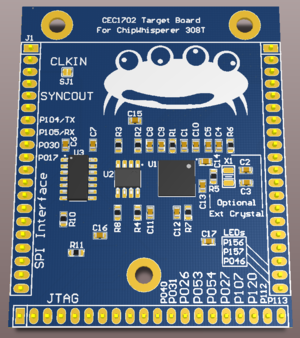CW308T-CEC1702
| CW308T-CEC1702 | |
|---|---|
 | |
| Target Device | MCHP CEC1702 |
| Target Architecture | ARM Cortex M4F |
| Hardware Crypto | AES, SHA, RSA |
| Supported Apps | [] |
| Programmer | Generic SPI Flash Programmer |
| Status | In Development |
The CW308T-CEC1702 incorporates the main chip with a 16MB SPI flash chip and a bi-directional SPI Buffer. The target board has standard power monitoring, UART serial, and clock In/Out compatibility with the CW308. JTAG pins and many GPIO pins are also exposed for prototyping and testing use.
I/O Connections
| CW308 Pin | CEC1702 Pin | Function |
|---|---|---|
| GPIO1 | P104 (TXD0) | Serial OUTPUT from CEC1702 |
| GPIO2 | P105 (RXD0) | Serial INPUT to CEC1702 |
| GPIO3 | P030 | GPIO |
| GPIO4 | P017 | Trigger pin |
| CLKIN | XTAL2 | Optional CLKIN |
| CLKFB | P002 (PWM5) | Can output 12MHz PWM on this pin. Useful for synchronizing to internal oscillator |
| J_TRST | JTAG_RST | JTAG Reset |
| J_TDI | JTAG_TDI | JTAG TDI |
| J_TDO | JTAG_TDO | JTAG TDO |
| J_TMS | JTAG_TMS | JTAG TMS |
| J_TCK | JTAG_CLK | JTAG Clock |
| LED1 | P156 | GPIO, Breathing LED0 |
| LED2 | P157 | GPIO, Breathing LED1 |
| LED3 | PA7 | GPIO, LED |
| PDIC | SPI buffer output enable, drive high to enable SPI programming and sniffing | |
| PDID/CS | QSPI0_CS | SPI chip select for SPI flash chip |
| H1 | P040 | GPIO |
| H2 | P031 | GPIO |
| H3 | P026 | GPIO |
| H4 | P053 | GPIO |
| H5 | P054 | GPIO |
| H6 | P027 | GPIO |
| H7 | P107 | GPIO |
| H8 | P120 | GPIO |
| H9 | P112 | GPIO |
| H10 | P113 | GPIO |
Hardware Cryptography
Multi-purpose AES Cryptographic Engine
- Hardware support for ECB, CTR, CBC, and OFB AES modes
- Support for 128-bit, 192-bit and 256-bit key length
- DMA interface to SRAM, shared with Hash engine
Cryptographic Hash Engine
- Support for SHA-1, SHA-256, SHA-512
- DMA interface to SRAM, shared with AES engine
Public Key Cryptographic Engine
- Hardware support for RSA and Elliptic Curve public key algorithms
- RSA keys length from 1024 to 4096 bits
- ECC Prime Field and Binary Field keys up to 640 bits
- Microcoded support for standard public key algorithms
Other Cryptographic Features
- True Random Number Generator
- 1 Kbit FIFO
- Monotonic Counter